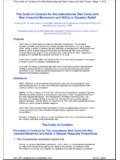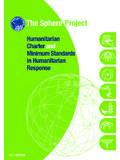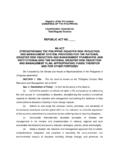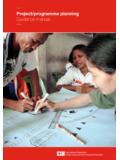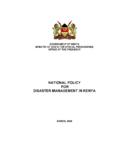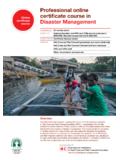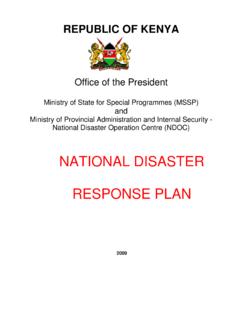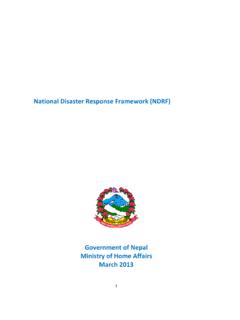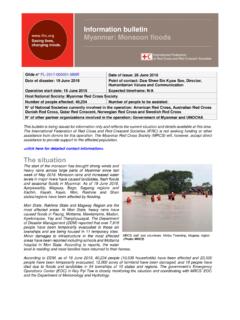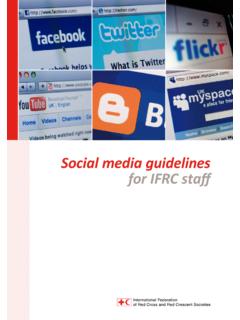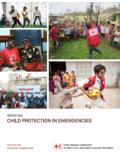Transcription of Princis and Ple rules for red cross and red crescent ...
1 PrinciPles and rules for red cross and red crescent humanitarian lives, changing minds. International Federation of Red cross and Red crescent Societies, Geneva, 2013 Any part of this document may be cited, copied, translated into other languages or adapted to meet local needs without prior permission from the International Federation of Red cross and Red crescent Societies, provided that the source is clearly stated. Requests for commercial reproduction should be directed to the ifrc at and rules for Red cross and Red crescent humanitarian Assistance1263500 10/2013 E 250 The International Federation of Red cross and Red crescent Societies ( ifrc ) is the world s largest volunteer-based humanitarian network, reaching 150 million people each year through our 187 member Na-tional Societies. Together, we act before, during and after disasters and health emergencies to meet the needs and improve the lives of vulnerable people.
2 We do so with impartiality as to nationality, race, gender, religious beliefs, class and political opinions. For more infor-mation, please visit and rules for red cross and red crescent humanitarian assistanceadopted by the XXi international conference of the red cross (istanbul, 1969) revised by the XXii, XXiii, XXiV, XXV and XXVi international conferences,tehran (1973), Bucharest (1977), manila (1981), Geneva (1986, 1995 noted)12 > PrinciPles and rules for red cross and red crescent humanitarian assistancePreambleThe National Red cross and Red crescent Societies (Nation-al Societies), the International Federation of Red cross and Red crescent Societies (International Federation2) and the International Committee of the Red cross (ICRC) together constitute the International Red cross and Red crescent Movement.
3 They form a worldwide humanitarian move-ment whose mission is: to prevent and alleviate human suffering wherever it may be found, to protect life and health and ensure respect for the human being, in particular in times of armed conflict and other emergen-cies, to work for the prevention of disease and for the promotion of health and social welfare, to encourage voluntary service and constant readiness to give help by the members of the Movement, and a universal sense of solidarity towards all those in need of its protection and assistance . 3 National Societies provide humanitarian assistance to peo-ple who are vulnerable in their territories in situations of disaster, crisis and conflict. National Societies act in accor-dance with the Fundamental Principles of the Movement (Fundamental Principles) and are auxiliaries to the public authorities in their humanitarian make best use of their collective capacities and to extend their operational reach, National Societies support each other in their humanitarian activities and contribute to each other s development.
4 As per the Federation s Constitution, the National Societies have created the International Federation to, among other functions, act as permanent body of liaison, co-ordination and study among National Societies , assist National Societ-ies in risk reduction, disaster preparedness, in the organization of their relief actions and the relief operations themselves as well as bring relief by all available means to all disaster-affect-ed persons and organize, coordinate and direct international relief actions in accordance with these Principles and This document replaces the Principles and rules for Red cross and Red crescent disaster relief, as endorsed by Decision 26 of the 1995 General Assembly. 2 The International Federation as used in this document refers to the International Federation as the corporate body created under its Constitution, which is comprised of its governance bodies (the General Assembly, the Governing Board, and the President) and the Secretary General supported by the Statutes of the federation of red cross and red crescent societiesThese Principles and rules for Red cross and Red crescent humanitarian assistance govern National Societies and their International Federation in international humanitarian assistance (excluding armed conflict, internal strife and their direct results).
5 These Principles and rules recognize the importance of strengthening organizational, coordination and delivery ca-pacities of National Societies, to respond to the increasing number and complexity of disasters and the growing num-ber of vulnerable people. They call for greater collective learning, adaptation, innovation and leadership to ensure that the Movement achieves greater humanitarian impact. These Principles and rules encompass preparedness for response, disaster relief and early recovery activities. They complement commitments to disaster risk reduction and seek to encourage National Societies to link relief, recovery and development. They establish a coordinated and agreed approach to quality and accountability, and recognize part-nerships with public authorities, humanitarian actors and other organizations external to the Movement.
6 These Principles and rules are adopted within the statutory framework of the Movement. These Principles and rules are adopted by member National Societies and their International Federation and will be pre-sented to the International Conference of the Red cross and Red crescent in 2015. They shall be a part of the future Move-ment-wide coordination and cooperation > PrinciPles and rules for red cross and red crescent humanitarian assistance1. We, the National Societies and the International Federa-tion, consider that all persons affected by disasters are entitled to receive assistance , consistent with their needs and priorities. 2. We respect the dignity of all people affected by disasters, including their meaningful involvement in decisions that affect their lives and We commit to protect people affected by disasters, particu-larly those made vulnerable by any form of discrimination.
7 4. We have the duty to bring humanitarian assistance to those in need. We partner with states, which have the pri-mary responsibility to meet the needs of disaster-affected people in their We advocate on behalf of people at risk and affected by disasters for increased action to address their vulnerabili-ties and unmet humanitarian We increase and expand our assistance through mobilis-ing our network. We commit that all international assis-tance provided by a National Society or the International Federation is with the consent of the National Society of the disaster-affected We are each other s primary and preferred partners. We pursue operational partnerships with external actors consistent with our Fundamental Principles to further increase operational reach, scale and effectiveness.
8 8. We ensure that our assistance is well coordinated among ourselves and with relevant external We ensure that our assistance is appropriate, efficient, ef-fective, and accountable, and we support the transition from relief to recovery for disaster affected people. 10. We provide international assistance that builds upon lo-cal capacities and complements local response mecha-nisms, contributing to preparedness for possible future disasters and strengthening long-term assistance adheres to the Movement s Fundamental Principles: it is based on humanity, respects impartiality, neutrality, and independence, is in conformity with unity and universality and builds upon voluntary federation of red cross and red crescent societiesrules between and among national societies and the international federation1 national societies receiVinG interna-tional humanitarian assistance (A) National Societies shall maintain an adequate level of preparedness to provide their own timely and effective humanitarian assistance in times of disaster, which re-duces the vulnerabilities of people at risk.
9 Preparedness measures may include but should not be limited to:a. Risk, vulnerability, capacity and market assessments;b. Development of contingency plans and processes with stakeholders; c. Monitoring and using regional and national hazard forecasts for early warning and early action;d. Conducting and concluding pre-disaster meetings and agreements;e. Convening and participating in simulation exercises with relevant partners; f. Building necessary volunteer, staff and organiza-tional capacity to provide timely disaster response; andg. Building necessary organizational capacity to re-ceive and account for international assistance . National Societies shall strive to continuously strength-en their auxiliary role to the public authorities in the humanitarian field, including through establishing clear roles and mandates as set out in applicable legis-lation, policies and plans.
10 National Societies shall encourage and support the relevant public authorities to review and develop leg-islation, policies and plans for disaster management, including by using the Guidelines for the domestic facilita-tion and regulation of international disaster relief and initial recovery assistance (IDRL Guidelines) to strengthen their overall legal, policy or institutional frameworks to both regulate and facilitate disaster Key outcomes of preparedness measures, including relevant agreements and cooperation arrangements concluded, should be shared with the International > PrinciPles and rules for red cross and red crescent humanitarian assistance (B) Requests for National Societies may ask the International Federa-tion to provide or facilitate international assistance prior to an imminent disaster on the basis of reliable scientific forecasts and early warning information.

